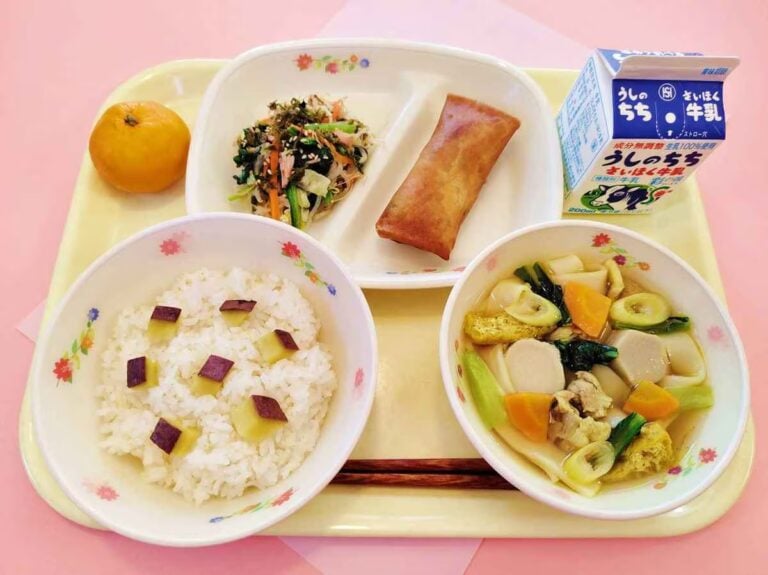
When I was little, nothing beat sitting at the lunch table, opening my lunch box, and discovering that my mom had packed me a fun treat, be it a blueberry muffin, Hostess cupcake, or fun size pack of M&M’s. Depending on what my friends’ parents had packed them, a trade might be agreed upon. Beyond how delicious the food tasted, I never thought much about what I was eating. Where it came from, the ingredients used to make it, and its nutritional aspects were just some of the many qualities that never crossed my mind.
In Japan, however, school lunchtime, or kyūshoku (給食), looks a little different. Not only is there simply one nutritionally balanced option for every student, it is also an integral part of teaching morality, socialization, and teamwork. Provision of school lunch began in the late 1800s during Meiji-era Japan and, after a brief hiatus during the years of the World Wars, eventually evolved to become the public school institution it is today.
So, what exactly is in a kyūshoku meal?
Most students will opt to eat kyūshoku all the way until the end of junior high school. Usually, the only time a student brings their own food is if they have dietary restrictions – a dairy intolerance, or religious reasons, for example. Even in cases like the former, however, they might still be served everything but a drink, and can instead bring their own from home.
A standard lunch consists of one main dish, usually a stew, noodles, or soup; a side dish, which might be salad, stir fried meat or vegetables; a carton of plain whole milk and occasionally fruit or a small pudding for dessert. The food is generally prepared in-house with minimal processing, and school nutritionists are tasked with creating menus that provide students with the micro and macronutrients required to fuel schoolchildren of all ages.
But do not mistake health with bland or boring taste – as if coming up with something healthy weren’t enough, as the nutritionists’ primary audience is between seven and fifteen years old, the food must also be tasty. At the very least, it should be prepared with the possibility of picky palates in mind. My favorite example of this wizardry at play is kyūshoku nattō (納豆) – fermented soybeans. While these pungent but nutrient-dense legumes are the stuff of many a foreigner’s (and occasionally Japanese children’s) nightmares, schools prepare them chopped and seasoned with miso paste. The result? As a self-proclaimed natto critic, I’ve been known to go for seconds!

If a student finds that even with these adjustments, nattō is not to their liking, no need to fear! The kyūshoku menu changes every day, and meals are only repeated every couple of months, at most. In an effort to instill appreciation for their local community and the food students eat, ingredients are often sourced locally, sometimes as nearby as the same town. On smaller islands, fishermen have even been known to sell some of their catch to schools to use. In an effort to further instill appreciation for the food being eaten, most school broadcasting clubs will also include the day’s menu and a short informational piece about one ingredient’s history or origin.
Lunch Time Procedure
You never have to wonder when school lunch preparation is underway. Shortly after the bell rings, the hallways begin to buzz with activity: students changing into their serving gear – some complain while others rejoice in the day’s selection – others pushing lunch trolleys with supplies to class, and still more carrying food in industrial-sized vacuum-sealed metal containers back to their classrooms. Yes, school lunch is eaten in the classroom!
In Japan, lunch is a collective responsibility – serving one’s classmates is not an occasional favor, it’s a given. The various roles required to get the food from the school kitchens into each student’s belly are rotated on a regular basis. Any given student in charge of a role is called the tantō (担当). Many students will be tasked with serving food and retrieving serving supplies, but even students who are not directly involved will line up to collect trays of food and deliver them to their classmates’ desks.
Kyūshoku’s role in Japanese society
And if you’re imagining the older kids doing all of this for the younger ones, think again! School lunch is a time for everyone to get involved. Yes, even the seven year olds learn how to do it. This extension of the responsibility to every student is one of the many inclusive aspects of school lunch in Japan.
This inclusivity extends to kyūshoku’s origins as well. It was first provided in Tsuruoka City in Yamagata prefecture by a Buddhist monk when he noticed that poor school children were coming to school without anything to eat. Eventually, this act of generosity grew to become what we know as kyūshoku today. And at ¥4,000-5,000 per month (between 26 and 33 USD), kyūshoku continues to act as a great equalizer, since even students from lower income backgrounds can experience eating dishes that their families may not be able to provide at home, whether due to financial or time constraints.
You see, school lunch is an extension of the principles and concepts taught in moral education lessons. Moral education forms an important part of the Japanese elementary school curriculum, as it is where students learn about social and emotional learning. The aim is to form socially-conscious members of society. School lunch is a great opportunity to teach children about group consciousness and the things teamwork and harmony can achieve.
The Japanese kyūshoku experience goes beyond mere nourishment; it serves as a cornerstone of education and community values. What kyūshoku lacks in Hostess cupcakes or Goldfish crackers, it more than makes up for in offering a structured, balanced meal that embodies lessons in socialization, teamwork, and appreciation for local ingredients. The collective responsibility of serving classmates fosters unity and teaches valuable life skills, aligning with broader educational goals in Japanese schools. Kyūshoku is more than just a meal; it’s a cultural institution that has nourished the bodies and minds of Japanese for generations.













